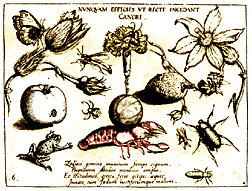
CONTEMPORARY CLASSIFICATION
At first glance, the order of the contemporary collection seems rationally defined, the functions of the objects dictating the nature of the categories. In some ways the modern classification of the natural world resembles the box-within-box structure of the sixteenth-century cosmos; categories are structured from the more inclusive to the increasingly specific. However, the trajectory of comparison in the modern paradigm is directed towards isolating the specific, identifying differences instead of similarities in order to divide the whole of creation into finer and more exact categories. Whereas the prized objects in the curiosity cabinet were those that blurred the divisions between categories, the prized objects in modern collections are those that clarify boundaries and define new categories.
 The idea of the naturally generated category is particularly prevalent in the
study of natural history. Taxonomies attempt to classify plants and animals
according to their presumed natural relationships, but there is still a great
deal that is arbitrary within this classification system. One important function
of collections for taxonomic systems is to preserve the specimens on which
classification is based; these archetypal specimens are called holotypes.
Identical specimens, from the same plant, animal, or area are called isotypes;
these may be indistinguishable from the holotype, but are not granted the same
status as paradigmatic example. For there to be no uncertainty about the
identifying characteristics and parameters of a particular classification, the
original specimen must survive (this makes the fires and bombings which major
collections have suffered in the last 100 years especially tragic).
The idea of the naturally generated category is particularly prevalent in the
study of natural history. Taxonomies attempt to classify plants and animals
according to their presumed natural relationships, but there is still a great
deal that is arbitrary within this classification system. One important function
of collections for taxonomic systems is to preserve the specimens on which
classification is based; these archetypal specimens are called holotypes.
Identical specimens, from the same plant, animal, or area are called isotypes;
these may be indistinguishable from the holotype, but are not granted the same
status as paradigmatic example. For there to be no uncertainty about the
identifying characteristics and parameters of a particular classification, the
original specimen must survive (this makes the fires and bombings which major
collections have suffered in the last 100 years especially tragic).
Although the use of holotypes provides a certain degree of stability to the
knowledge built on this process of identifying, naming and analyzing the world,
and provides markers against which to measure evolutionary change, the different
values given to nearly identical specimens of the same species seems irrational.
Why is one sample chosen to serve as a marker or boundary and not another? How
can our classification of the natural world be seen as intrinsic or stable when
what it reveals most clearly in nature is a permanent state of flux and
transformation? Why are archetypes so important to us when evolution depends on
constant mutation?
 |
{Essays} {Gallery} {Microcosms} |
 |